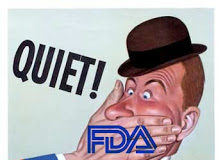The pharmaceutical industry must be reeling from the blow just recently delivered by Senate Majority Leader Bill Frist (R-TN) who called upon the drug industry to impose “a two-year moratorium on advertising for new drugs and a government audit to determine how drug ads have affected the way Americans are treated for illness.” (see “Senate leader seeks moratorium on ads for new prescription drugs,” USA Today, 6/30/2005).
Back during the 2004 election campaign, DTC advocates in certain trade publications and associations raked the democrats over the coals for making DTC a campaign issue. John Edwards, the democratic candidate for VP, was especially vilified because of his support of an amendment to the Medicare Modernization Act that the advocates claimed would “bring an end to DTC.”
For example, here’s what the Association of National Advertisers had to say about Edwards’ amendment:
“We strongly feel that this new and misguided amendment should be … Vigorously opposed … It threatens to eliminate a broad segment of DTC broadcast advertising and would make print advertising for drug products prohibitively expensive.”
Yet, Edwards merely wanted DTC ads to include more fair balance information in print and TV ads, not ban them outright. In the post-VIOXX era this tweaking of DTC is a given (see, for example, “Marketing in the Post-Vioxx Era“).
AMA Weighs In
The American Medical Association (AMA), which recently voted to study whether consumer drug advertising leads to unnecessary prescriptions (see “A.M.A. to Study Effect of Marketing Drugs to Consumers“), at its annual meeting heard several proposals that featured distinctly Edwards-like approaches to fixing DTC. The following resolution, for example, was introduced by the Oregon delegation:RESOLVED, That our American Medical Association support the concept that the Food and Drug Administration (FDA) require inclusion of comparative quality data in direct consumer advertising of drugs, thus creating a basis for more informed consumer choice and encourage the FDA to develop new standards for drug advertising to consumers that are grounded in data derived from systematic research. (See “Truth in Direct-to-Consumer Advertising“)
Take Arms or Suffer the Slings and Arrows?
Now the leading Republican candidate for the presidency in 2008 has gone much farther than the Democrats dreamed of in 2003. “… let there be no mistake” said Frist, “drug advertisements fuel America’s skyrocketing prescription drug costs.” For his full speech, see Frist’s Senate Floor Statement to the Senate.To ban, or not to ban DTC advertising: that is the question:
Whether ’tis nobler for the pharma industry to suffer
The slings and arrows of politicians seeking the office of presidency,
Or to take arms against a sea of troubles, Republican and Democrat
And by opposing end them?I don’t expect Pharma to roll over and die as Hamlet seemingly wanted his enemies to believe he would do. Although there have been some chinks in the armor (e.g., BMS’s self-imposed ban on new drug DTC advertising for one year; see “New DTC Principles Emerging“), it is not expected that the industry will cave in without a fight. The one-year ban that BMS pledges, for example, won’t be part of the principles that PhRMA is said to be developing — at least that is what I hear.
[It will be interesting to see how the pharma industry and DTC advocates will handle the Frist situation. A better literary reference might have been Shakespeare’s Julius Caesar’s “Et tu, Brute?” But, in that play, Caesar chooses to accept the dagger rather than fight his friend. I don’t think pharma will accept Frist’s dagger. In any event, both Hamlet and Caesar were tragic figures in that they were high and mighty and had a great fall. It remains to be seen if the DTC drama playing out before us is a tragedy or not. It certainly isn’t a comedy.]
My Humble Opinion
For my views on how DTC advertising should be linked to drug safety, see “A Proposal for a Drug Risk Advisory System.” I suggest that drug companies prove that their products are as safe as can be before advertisingg them to the public and that they be given incentives to do this by extending the patent life of drugs while post-marketing surveillance studies are going on.









![6 Digital Tools at the Center of Healthcare Digitalization [INFOGRAPHIC]](http://ec2-54-175-84-28.compute-1.amazonaws.com/pharma-mkting.com/wp-content/uploads/2021/04/6DigitalTools_600px-100x70.jpg)




